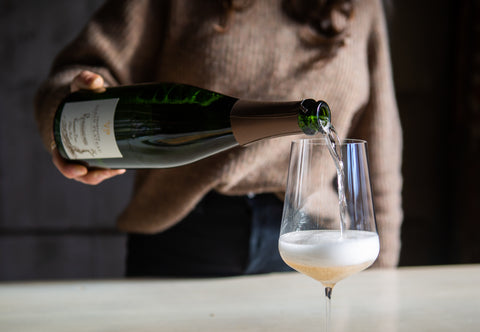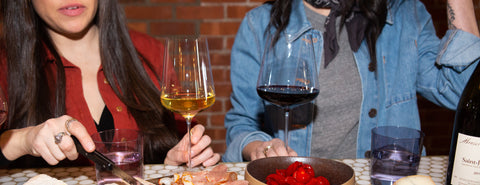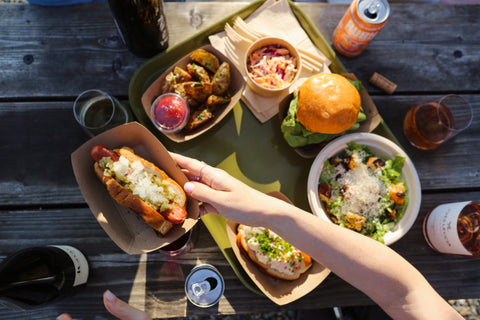Champagne: not just for special occasions. Saturday brunch? Solo dinner date? Curling up with a good book on a foggy day? It adds a layer of deliciousness to all of it. But because of very successful marketing campaigns of generations past — and a higher price point thanks to the labor-intensive production process — it's become mostly associated with special occasions. And the myths people have come up with the keep Champagne clouded in hype have proliferated.
Let's dig into some of those myths, from the origin story of Champagne to swirling.
You can’t swirl your Champagne
Yes you can! For two reasons. One, Champagne is highly pressurized, which means it’s jam-packed with bubbles (unlike Prosecco, which is less pressured and has larger, less tightly packed bubbles). The second is that Champagne is aromatically complex; winemakers spend an insane amount of time agonizing over how they blend and age their Champagne, all to create an intricate, deep, many-layered drinking experience.
When you first pour a glass of Champagne, the ferocity of the bubbles can swamp the complexity. We swirl our Champagne a few times to let it breathe and release some of those complex, delicious aromas. You won’t lose the bubbles and you’ll be better able to appreciate your wine.
You need a coupe…or a flute
There’s no need to buy special glasses just for Champagne. Flutes are great for Prosecco and other sparkling wines made with less pressure — they can lose their bead more easily. A coupe is beautiful, but the broad surface area and minimal wall mean that you lose most of the aroma. Champagne is best served in a traditional white wine glass, something that allows you to bury your nose and appreciate all of those rich, complex aromas.

Champagne is for special occasions
One of the biggest myths of all! Champagne is the hallmark of special occasions, but that’s mostly because of great marketing. There’s no reason you shouldn’t enjoy a finely crafted bottle of Champagne with a Saturday brunch at home.
Pop that cork!
The myth here isn’t that it’s wrong, it’s just that it’s not inherently better to spray your Champagne. There’s a unique sadness to watching someone pop the cork of great Champagne and let half the bottle explode out on the ground. It’s understandable, to an extent. It acknowledges that good times and great friends are more important than the dollar value of that spilled wine. On the other hand, Champagne is labor and time-intensive. We’re not crazy about pouring out countless hours of painstaking labor on the floor, especially when it’s the labor of winemakers we want to celebrate.

Better Champagne is more expensive
Some bottles from well-known Champagne houses run upwards of $300, but you don’t need to pay that much. At Dedalus, we champion small houses as well as grower Champagnes, grown and vinified by the same estate. Some are available for as low as $60 or $70. That price reflects the massive amount of labor, the cost of the land, and the long aging time, but not the massive marketing budget of larger houses.
If the bottle says “Champagne,” it’s from Champagne, France
Indeed, Champagne can only be made in Champagne, France, and it’s illegal to label a wine Champagne if it’s made outside the region. However, you might see bottles labeled “California Champagne” on some supermarket shelves because of a loophole in the Treaty of Versailles, the international agreement that ended the first World War. The treaty was supposed to protect French Champagne from copycats, but because it was only signed and never ratified by the U.S. government, California winemakers were still able to use the name.
Then, in 2005, the U.S.A. reached a new agreement with some European countries. They agreed that no American winery could launch a product with the name “Champagne.” But if they were already using the name, they would be grandfathered in. That’s why you’ll see certain bottles labeled “California Champagne.” The loophole is still a sore point for Champagne producers.
Dom Perignon invented Champagne
It’s a great story: In 1693, a Benedictine monk accidentally stumbles on the formula for creating sparkling wine and calls over his brothers, saying “Come quickly, I’m tasting the stars!” Dom Perignon contributed significantly to the history of Champagne, but not by inventing it. He made advancements in the arena of blending and viticulture that are still with us today. The quote was first published in print ads from the 19th century.
A spoon keeps Champagne from losing its bubbles
Don’t fall for it! A spoon has zero effect on the bubbliness of your already-opened Champagne. If you don’t plan on finishing the bottle, buy a specialty Champagne stopper, pop it on, and stash your Champagne in the fridge until you’re ready to break it out again.
Nonvintage is better than vintage Champagne
Not better — different. A vintage Champagne is made with grapes from one specific year (vintage.) A non-vintage Champagne is made with grapes from various vintages. Non-vintage Champagne from a specific house will taste pretty much the same, regardless of when it’s released, because of the intricate blending that goes into achieving a house style. Vintage Champagnes are less about staying the same and more about being completely itself. They’re typically only produced in the years where conditions are absolutely perfect — otherwise, they’re blended into a non-vintage year to achieve a better balance.
Rosé Champagne is sweet
When it comes to Champagne, pay less attention to the color and more to the label, where the level of dryness (or sweetness) is very clearly described.
In order, from driest to sweetest:
- Brut Nature
- Extra Brut
- Brut
- Extra Dry
- Sec
- Demi Sec
- Doux
Now that you’ve busted these myths, it’s time to enjoy Champagne with a whole new perspective. Shop our lineup of hand-picked grower Champagnes today.



